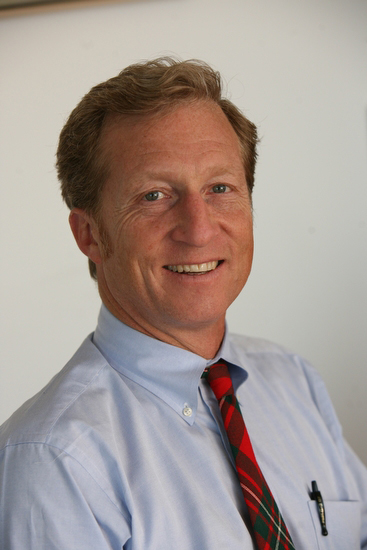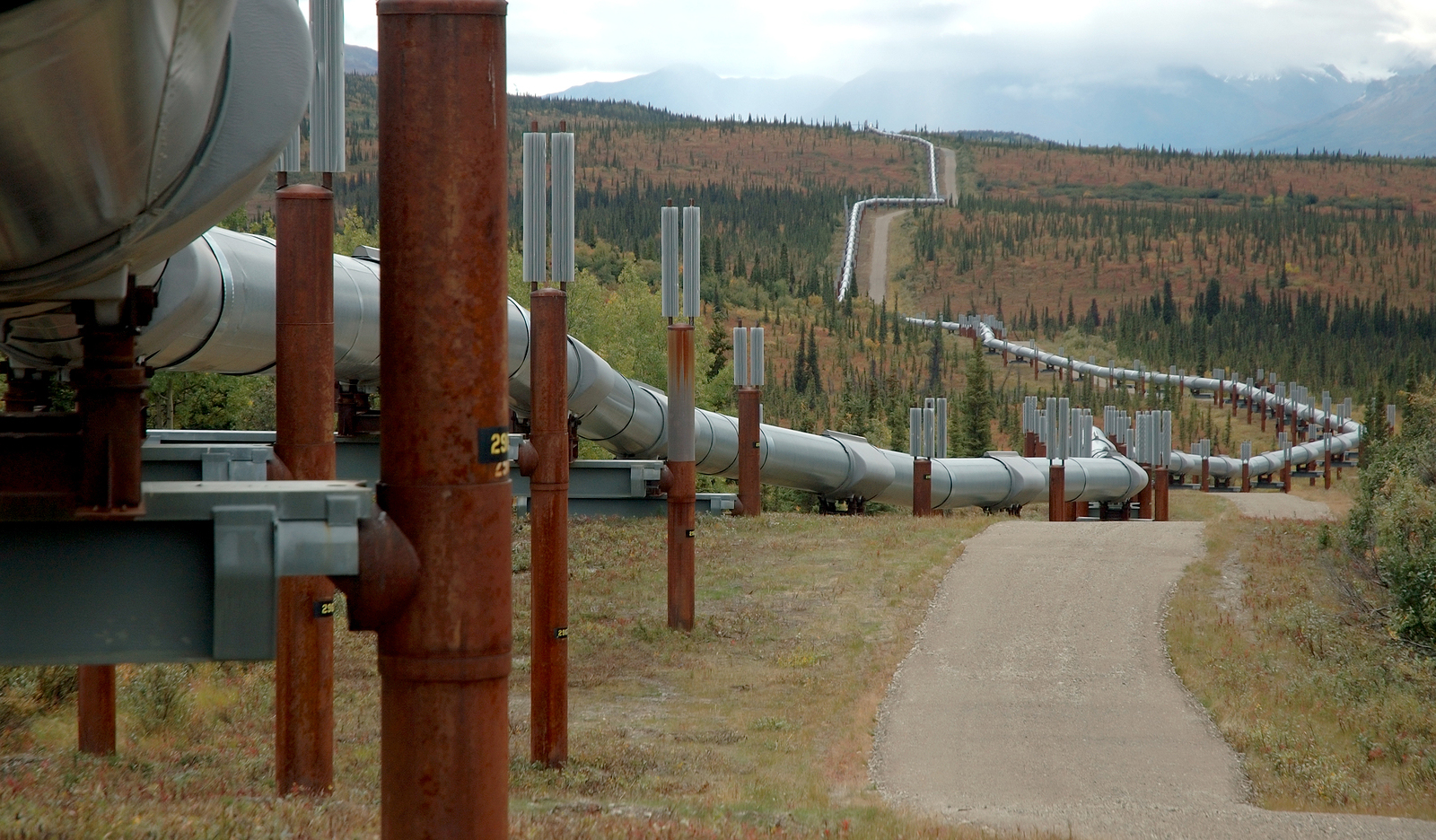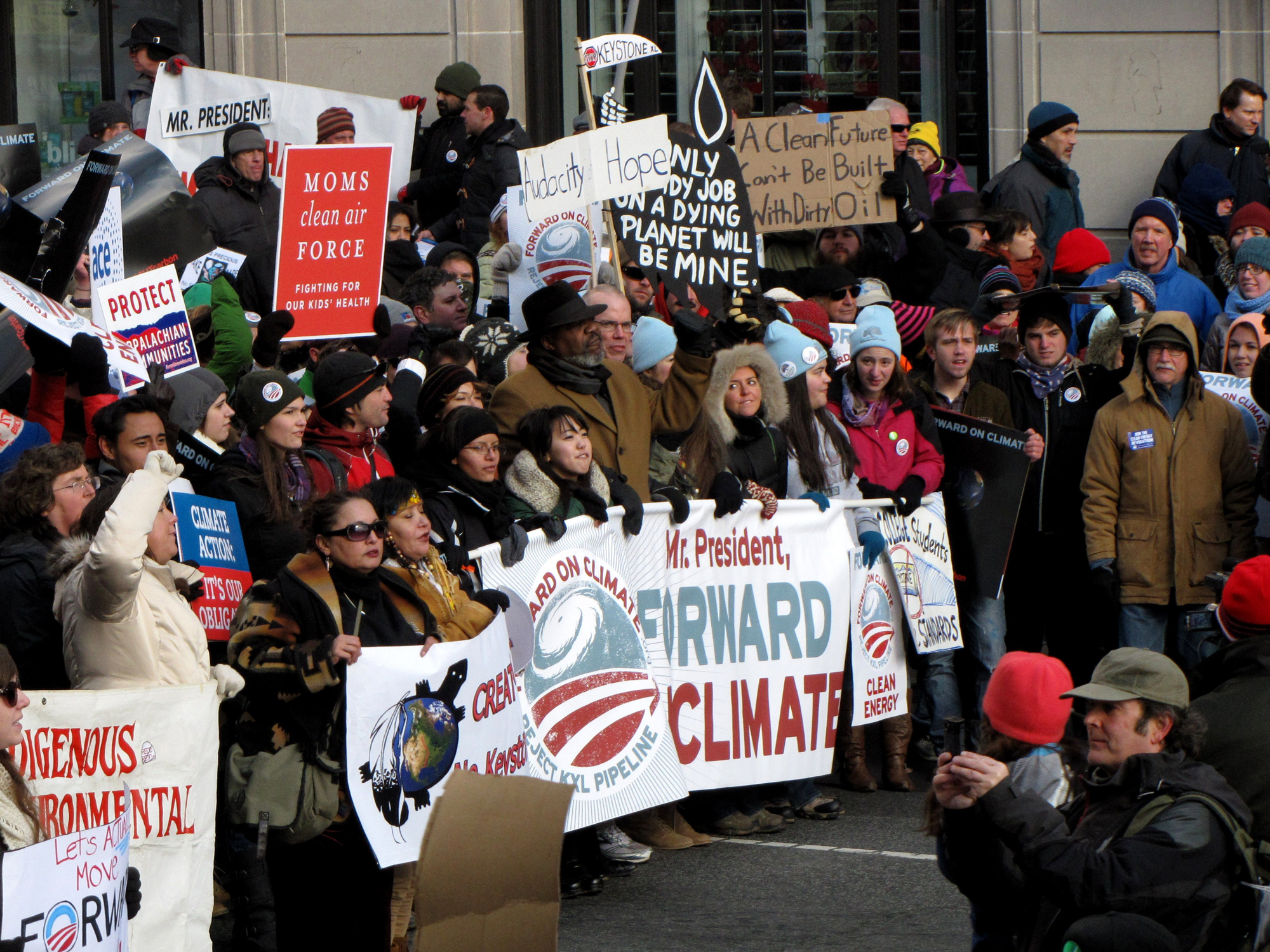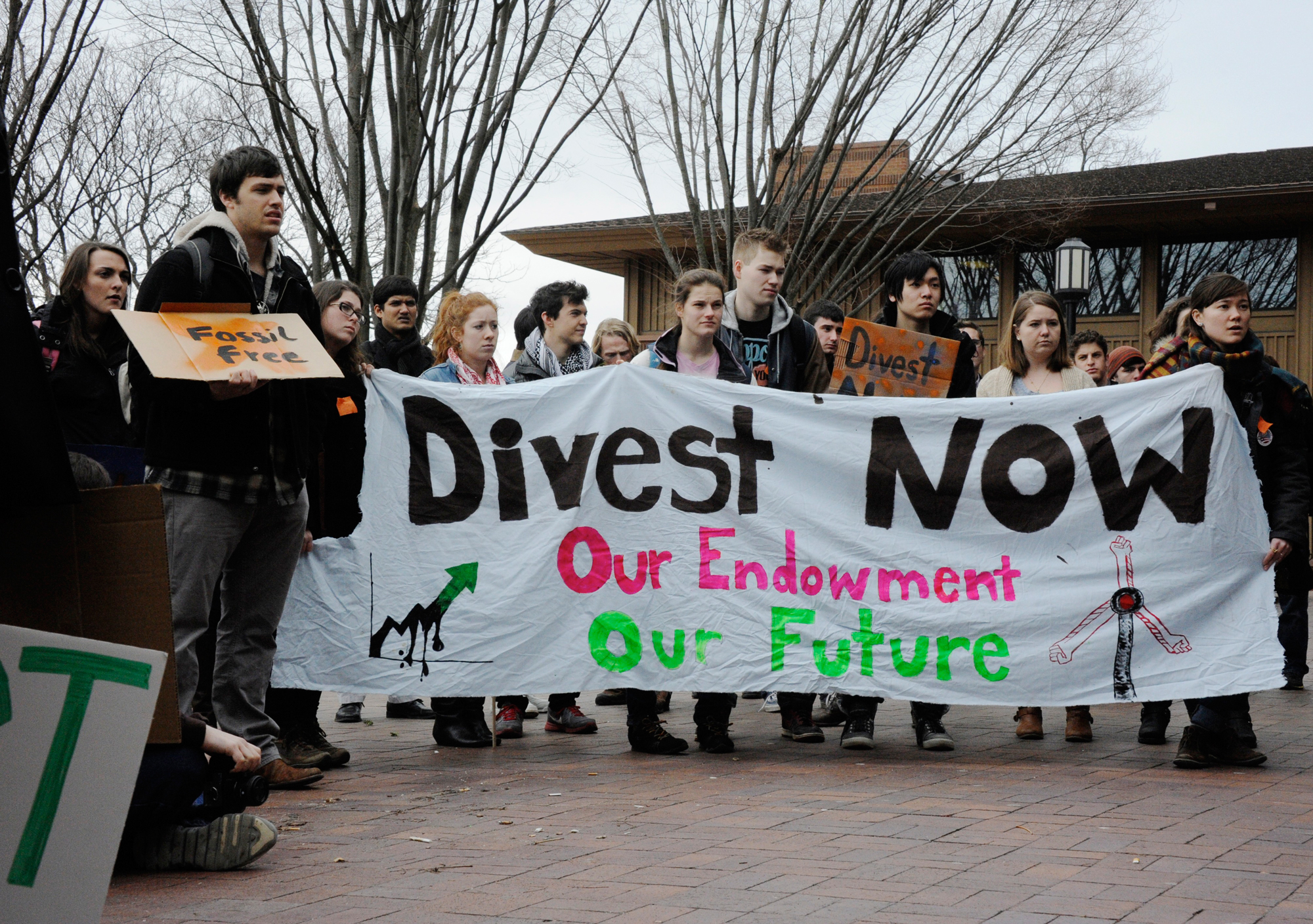Risky Business
Air Date: Week of January 17, 2014

Keystone Protest in Washington DC (photo: Tar Sands Action)
Billionaire and green activist Tom Steyer has partnered up with former NYC Mayor Michael Bloomberg and former US Treasury Secretary Hank Paulson to form an organization called “Risky Business.” Steyer tells host Steve Curwood the mission of the organization is to quantify the growing risks of climate change.
Transcript
CURWOOD: From the Jennifer and Ted Stanley Studios in Boston, this is Living on Earth. I’m Steve Curwood. Tom Steyer isn’t your typical environmental activist. Nor is he your typical Wall Street billionaire. The founder of Farallon Capital has mostly dropped out of the investment game to become a warrior in the fight against climate change. His weapons are dogged determination, an enormous checkbook, and access to some of the most powerful people on the planet. Tom Steyer recently joined with former New York mayor Michael Bloomberg and ex-Treasury Secretary Hank Paulsen to found Risky Business, an organization that quantifies the economic risks of climate change.
We sent an audio engineer to Tom Steyer’s office in San Francisco to record this interview, but sadly before she could send the recording to us, her gear was stolen from her car, leaving us just with the phone connection. But you should be able to hear him just fine. Tom Steyer, welcome to Living on Earth.
STEYER: Thank you for having me, Steve.
CURWOOD: So tell me, why did the three of you come together to start Risky Business?
STEYER: Well, I think that all three of us were concerned that we frame the energy and climate issue in the United States in a thoughtful and responsible way, and we thought that together we were stronger than apart because we had different political affiliations and different backgrounds, and we live in different parts of the country. We felt as if we were going to try and address a national issue with people who are geographically and politically dispersed.
CURWOOD: Now how does climate change alter the investment and business landscape in this country, do you think?

Tom Steyer (photo: Next Generation)
STEYER: I think that when people are making investment decisions what they’re trying to do, to a very large extent, is to anticipate and forsee all the possibilities in the future. So when we talk about a dramatic change to the natural environment, you’re talking about something that is going to change in some ways that we can predict, and in many ways that we can’t predict, outcomes of how people are going to live and how economies are going to work. I think businesses are already taking into account the changes that may occur and will occur in the natural world, and also trying to anticipate governmental responses to those changes. So in thinking about what we’re doing in Risky Businesses, we’re trying to set a framework where we agree on kind of what’s likely to happen so that then, subsequently, we can talk about what we should do about it.
CURWOOD: So, fossil fuels have long been considered sure bet stocks, but at this point, in your view, how prudent is it to be investing in fossil fuel stocks from an economic perspective?

An oil pipeline in Alaska (photo: bigstockphoto.com)
STEYER: [LAUGHS] Well, I think that the question for fossil fuel companies that have decades of reserves to produce is whether the way that we generate and use energy is going to change over those decades, and to the extent that there’s a lot of value put on the out years, then the question is, “is the world going to have changed enough that for some reason the way that we’re used to generating and using energy will have to change?" If that’s the case, then you got to include that in your investment thinking, your projections of the future.
CURWOOD: And what do you think is the answer to that question?
STEYER: I think there are only two possible outcomes: either all the scientists are wrong or we’re going to have to generate and use energy differently. The reason we’re doing Risky Business is to try and show the different scenarios that can happen so that people can start to think about how they should anticipate the future differently. So in my opinion, I don't think there's any question: either the scientists don't know what they're talking about or as a society we have to start to make different decisions about how to generate and use energy.
CURWOOD: Now, rather than an investment response, we’ve seen a social response on this investment question, if I could put it that way, with the fossil fuel divestment movement picking up steam around the country. What role do you think divestment can play in the climate change fight?

Keystone protesters marching in Washington (photo: Ben Schumin)
STEYER: Well, I view divestment as primarily a political statement and an ethical statement and a moral statement. And let me just define that for you for a second, which is this: if a college endowment divests $3 million worth of Exxon stock in the real world does that change the cost of capital for Exxon? I would argue no, that is de minimis change in a huge capital market. I think something else is going on, which is without trying to demonize fossil fuel companies - because I do believe that the actual answer to the way we will generate and use energy in new ways will be created and promulgated by business - the point of a university divesting is to make the statement that we have to make a change. That’s the point of divestment is, for institutions which have high ideals to gird their loins and say it is no longer OK for us to continue with business as usual, as a society we need to confront this and do what we do best, which is rise to the challenge and come up with innovative solutions that will actually make us better off in the long run.

The fossil fuel divestment movement has taken hold around the country. Tom Steyer says divestment is an important moral statement (photo: James Ennis)
CURWOOD: By the way, I think you’re on the board of one of your alma matters, the Stanford B-school. Have you offered any advice about divestment there?
STEYER: We have talked about it, and Stanford has been studying it. I have actually funded two centers at Stanford to study and work on new energy solutions and climate change. So the university is definitely engaged in that fight, and they are trying to find the best ways to try and lead in it. They have not divested, and it is something which is under discussion and evaluation.
CURWOOD: What about your own personal holdings? What do you have in terms of fossil fuels these days?
STEYER: I have done that, I mean we have invested for 30 years across the spectrum of investments, and I have been working since I have left Farallon to try and make sure I don’t have fossil fuel investments because I actually feel that it’s important to be consistent in what you do, and I feel that for me to be sitting here advocating the change for everybody else, I have to already have made that change myself.
CURWOOD: So one of the largest fossil fuel investments that sits on the board right now, of course, is the Keystone XL pipeline and you put a lot of money into opposing Keystone. Why is this such a big issue for you?
STEYER: If you examine what’s really going on with that pipeline, it is enabling a remote and gigantic fossil fuel reserve that is very dirty to come to the world market. It is decades of production, and it’s the kind of thing which is going to be very, very difficult or impossible to turn off. So it’s a perfect example of where business as usual will lead us to a place that could well, you know, be extremely difficult and painful, and therefore to allow it in the first place is a big mistake.
CURWOOD: So, Tom Steyer, you’ve made a lot of money on Wall Street, but I wonder how many billionaires have gone to the Mall in Washington [DC] to speak out at a protest march the way you did in the Keystone demonstration last year.
[CHEERS]
RECORDING OF STEYER ON MIC: We can’t afford 40 more years of dirty energy.
[CROWD YELLING “NO”]
RECORDING OF STEYER ON MIC: We can’t afford the droughts, the storms, the disasters...
[CROWD JEERS]
RECORDING OF STEYER ON MIC: And most of all, we can’t afford not to build a cleaner, cheaper, more secure energy system.
[CROWD CHEERS]
CURWOOD: Well, you got a lot of applause there, Tom Steyer. How did it feel to give a speech like that?
STEYER: [LAUGHS] Well the funny thing - I'll say two things about speaking at the Mall, it was a really, really cold day, and I tried to keep my remarks as short as possible because people were freezing, and second of all, my then 21-year-old daughter had come down from college to listen to the speeches, and I was extremely intent on trying to say something that I thought was both true and positive and forward thinking, thinking of her and the people of her age and trying to represent our generation in speaking about what is good and how American democracy really works, which is when people confront our problem they come up with new ideas and positive ideas. I wanted to make sure she knew that I and the rest of our generation was going to do that.
CURWOOD: Tom, why have you made this issue the primary focus of this phase of your life?
STEYER: Well, I think that...it’s funny...Keystone has a huge, and we discussed it, impact from a substance level, and it also has a huge symbolic impact. The United States of America is arguably the leading country in the world from a political standpoint and an economic standpoint, and when we make decisions people watch very closely and they take cues from it. In addition, this is very specifically a global pollution problem. We can’t solve this by ourselves. So if you’re going to lead a coalition, or participate in the leadership of a coalition, it’s really important you have some credibility to do the right thing. There’s going to be a big international climate conference in Paris, in December of 2015. It’s very important that good things come out of that, and for us to lead, we have to basically say, "we’re willing to make the hard decisions, we recognize the situation, and we’re doing the right things, and that’s why we have a right to encourage you to do the right things as well, so we can get on a path to sustainability as soon as possible". So, therefore, when we think about Keystone and say, “oh we can just do the wrong thing,” and then we can go to everyone else in the world and say, “but you must do the right thing,” I don’t think that will wash for one second.
CURWOOD: You know, historically, policy hasn’t really solved things. We knew slavery was wrong, but there was a social movement. The rights of women, again, there was a social movement. Civil rights, a social movement. What role, if any, do you feel you need to play in the social movement to change the perspective on the urgency of the climate question?
STEYER: Let me say this: we have been involved in a number of campaigns inside California and outside California, and it is absolutely clear to us that for this to get political momentum, the understanding and concern and urgency must be shared across a very broad part of society. And in fact, what we’ve seen surprises most people because they have, in my mind, cliched images of who cares about energy, climate and the environment.
The truth is that across the United States, and very definitely in California, the ethnic group that cares the most about the environment is Latinos, number two is Asian Americans, number three is African Americans. The fact is we need a broad base group not limited to the people who necessarily label themselves as environmentalists or are labeled as environmentalists, that is definitely bipartisan and includes both organized labor and business groups. Until that happens, we won’t have enough political oomph so that elected officials feel like the time has come when we absolutely need to act.
CURWOOD: By the way, you didn’t mention faith-based groups in those movements. Any role here for them do you think?
STEYER: Absolutely. I speak at churches and places of worship fairly regularly, and I love to do it because my feeling is that people of faith see this thing in two very powerful ways: one is that it is incredibly important to protect what God has given us, and second of all, I think people feel very strongly that we must protect the poorest among us. And they are under the - in my mind, correct assumption - that people who will bear the cost of this the most will be the poorest people. And so I think, faith-based groups are people who respond, in my experience, very emotionally and powerfully to this.
CURWOOD: Tom Steyer is the Co-founder of Next Generation and one of the Co-Chairs of Risky Business. Thanks so much for taking the time with us today, Tom.
STEYER: Steve, it's a pleasure. Nice to meet you.
Links
Living on Earth wants to hear from you!
Living on Earth
62 Calef Highway, Suite 212
Lee, NH 03861
Telephone: 617-287-4121
E-mail: comments@loe.org
Newsletter [Click here]
Donate to Living on Earth!
Living on Earth is an independent media program and relies entirely on contributions from listeners and institutions supporting public service. Please donate now to preserve an independent environmental voice.
NewsletterLiving on Earth offers a weekly delivery of the show's rundown to your mailbox. Sign up for our newsletter today!
 Sailors For The Sea: Be the change you want to sea.
Sailors For The Sea: Be the change you want to sea.
 The Grantham Foundation for the Protection of the Environment: Committed to protecting and improving the health of the global environment.
The Grantham Foundation for the Protection of the Environment: Committed to protecting and improving the health of the global environment.
 Contribute to Living on Earth and receive, as our gift to you, an archival print of one of Mark Seth Lender's extraordinary wildlife photographs. Follow the link to see Mark's current collection of photographs.
Contribute to Living on Earth and receive, as our gift to you, an archival print of one of Mark Seth Lender's extraordinary wildlife photographs. Follow the link to see Mark's current collection of photographs.
 Buy a signed copy of Mark Seth Lender's book Smeagull the Seagull & support Living on Earth
Buy a signed copy of Mark Seth Lender's book Smeagull the Seagull & support Living on Earth

